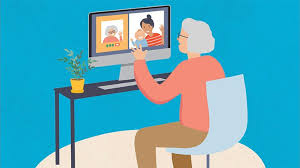 The articles are beginning to appear here and there. In the time of Covid-19, some are talking about an increasing use of technology in their nursing homes. Others are discussing the race to enable ‘televisits’ -- noting outreach from AARP to CMS to boost the requirement for enabling technology in nursing homes. And numerous other articles have appeared that showed nursing homes receiving donations of technology. The State of Florida gave tablets to 150 nursing homes. The attorney general of Massachusetts supplied 750 tablets to nursing home residents. And Texas provided $3000 per Texas nursing home for tablets, webcams, and headphones. The pictures associated with some of these introductions of technology were bleak. Fortunately, some states are now allowing families to visit residents in designated areas outside.
The articles are beginning to appear here and there. In the time of Covid-19, some are talking about an increasing use of technology in their nursing homes. Others are discussing the race to enable ‘televisits’ -- noting outreach from AARP to CMS to boost the requirement for enabling technology in nursing homes. And numerous other articles have appeared that showed nursing homes receiving donations of technology. The State of Florida gave tablets to 150 nursing homes. The attorney general of Massachusetts supplied 750 tablets to nursing home residents. And Texas provided $3000 per Texas nursing home for tablets, webcams, and headphones. The pictures associated with some of these introductions of technology were bleak. Fortunately, some states are now allowing families to visit residents in designated areas outside.
Ending the era of no-tech to at least some tech. The lockdown visitation rules were terrible for residents. But they also exposed gaps of capability in senior-focused communities. These may have revealed -- like the AARP recent survey of the 70+ age group -- the lack of adoption of devices and tech among the oldest. Furthermore, banning families and visitors may have exposed the role that visiting families play in care. Also consider role of volunteers who bring in activities, the lack of technology access for residents, including broadband/Wi-Fi, the difficulty of providing telehealth services in these environments. These issues will only be better understood as senior housing communities are surveyed, and it is possible to figure out what policy or business changes have made a difference.
When the crisis has passed, what will the differences be in terms of tech in senior living? Let’s assume that the tablet distribution initiative takes off – for nursing homes -- not noted in press releases or media reports. One day in the future, after the tech surveys are conducted, looking at the post-pandemic world from a technology perspective, will it be a whole new day in senior care? What will be different in that year?
Nursing homes and senior living communities will all have Wi-Fi for residents. And from there, all else tech-wise will become possible. Let’s imagine a scenario:
"Following discharge from the hospital after hip replacement, Mrs. Smith is brought by ambulance to the rehab wing of a local skilled nursing facility. Her family has already notified the community to activate her in-room Wi-Fi (an extra charge). When she is settled comfortably after dinner, she has an online session (launched by her son) with grandchildren using her tablet that is now on her tray table. After that, the caregiving aide speaks a music request to the Echo Dot (or Google Mini) also remotely set up by her family, and Mrs. Smith nods off to sleep. The next day, she speaks her menu requests for lunch and dinner and is notified by the in-community reminder system that she has scheduled rehab in the afternoon at 2:00. Later that day, she also listens to music, plays a game on her tablet, chats online with her relatives, is taken to rehab, listens to an online book, and later participates in a community-wide in-room activity from her tablet. Her family is alerted to her level or lack of physical activity, and also the frequency with which her room is entered by staff. Her pull-cord has been replaced -- she need only speak a request. The staff doctor speaks his observations about her recovery, and those are instantly available at the nurses' station. Her progress is being charted and her discharge instructions accumulated during her stay that be available by voice when she moves to a more permanent location."
Why not? Perhaps this is already possible in some place you know about. If so, please comment.

Comments
From Dan Rexford via LinkedIn
Must robust telehealth become standard, enabling communities to care for residents in-house?
From Sheena Jaffer via LinkedIn
It had to be leveraged in a win-win for all.
From Terri Sullivan via LinkedIn
Covid-19 will push the industry 10 years forward. Helping residents with isolation and better overall wellness through connectivity. Yes! Yes! Yes! I love watching the world lean into tech.
From Anna Hall via LinkedIn
We need to get social/ voice technology into healthcare to improve patient experience/ outcomes. Mind/body/spirit can be nurtured with access to the right technology. Love the example you shared.
Rethinking the Nursing Home Model
The Institutional Care model will survive for some, but not for many. Already it is less than 10% of the overall aging care space, with most elders preferring to age in place.
But the pandemic will shrink even that small number more. Already families are pulling Residents out of Nursing Care facilities. And many staff are no showing up for work. Finally, there is no assurance that a vaccine whenever it arrives, will be as effective in vulnerable communities, which includes seniors.
So my question is this: Is anyone imagining a new model of long term care.
I have started to address the systemic problem of aging in an article for Atlantic magazine.
You can read it at https://www.kin-keepers.com/an-enchanted-cave-for-caring/